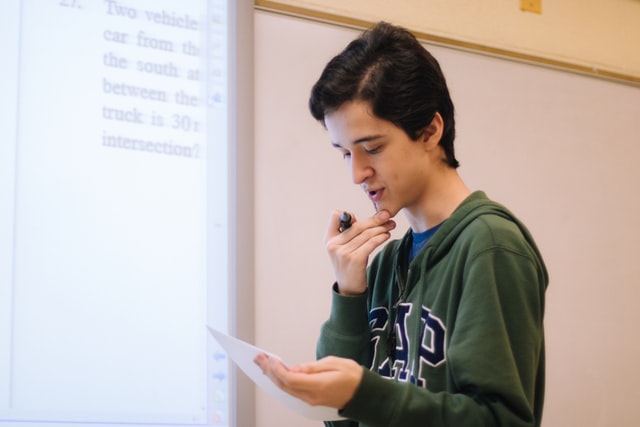There are many approaches to teach math to students and each has their advocates. Generally, however, teachers today apply a mixture of approaches in order to help students see how these numbers work in various contexts and formats. This helps students’ brains be able to better understand the answer they need to find as well as recognize what tools to use to solve the problem.
Writing down math problems as math formulas is useful in that it notates exactly which mathematical operations to do in each problem with the various symbols such as plus signs, division lines, and square root numbers. All students need to do is learn to recognize the instructions and the answer is as simple as doing basic arithmetic, or these days just plugging it into the calculator.
However, math formulas aren’t the only way to represent a problem for students to solve. Word problems state real world situations in which the student must use mathematical operations in order to answer the question. This approach can be difficult for many students as it doesn’t directly state which mathematical operations the student will need to employ to find the answer.
While this might seem to be an extra layer of difficulty that teachers don’t want to go into until students understand the operation in the clearer formula presentation, recent research suggests that a linguistic understanding of numbers is crucial in order for students to understand how they work in practice.
While each student will find different approaches to teach math effective for them, especially for students with learning difficulties such as dyscalculia, it is important to see how the brain processes numbers fundamentally when deciding the best approaches to teach math so that students can have a strong basis before moving on to more abstract concepts. But are words really fundamental in order to be able to deal with numbers?

New Research on Teaching Math
A recent study on the relationship between language and mathematical understanding was conducted by MIT on people from the Tsimane tribe located in the Bolivian rainforest. (Pitt et al.) Research on the relationship between language and math is difficult as most languages have a word for every number, but deep in the rainforest of Bolivia, the Tsimane tribe’s local language only has words for numbers up to 100 and then some use borrowed words from Spanish for the numbers after that. However, what number members of the Tsimane tribe can count up to varies widely as large numbers simply don’t play as significant of a role in their lives.
The researchers were interested in how this limited ability to express larger numbers would affect a person’s ability to deal with larger quantities of real world objects. They recruited 15 people who could verbally count somewhere between 6 and 20 and then 15 people who could count to 40 or beyond.
They then gave both groups a task called “orthogonal matching” to complete where participants are shown a line of objects in front of them and asked to make a line of objects containing the same number of objects. The participants can not simply match one to one however as they are shown the line of objects in a horizontal line in front of them, but must make their line vertical so that it isn’t a simple matching task. The participants must mentally count the objects in the line and theirs to ensure a matching number.
The results showed that there was a clear link in the ability to verbally represent numbers and the ability to match the objects in the orthogonal matching task. Participants were generally able to match lines up to numbers just below how high they could count. So if the participant could count up to 25, they would start to guess and make mistakes around 23 while those who could only count to 10 would struggle with even making a line of 8 or 9.
In addition to the findings from this experiment, the researchers also found that the Tsimane have a different timeline for learning numbers than students from more industrialized societies. In these industrialized societies, there is a greater emphasis on numbers and counting that starts at a very early age. Generally, children begin to start counting and understanding numbers at around 2 years old and have a firm grasp on the concept by the age of 4 to 5. In the Tsimane tribe, however, children begin to start counting around age 5 and master the basics around age 8.
This finding along with the finding from the orthogonal matching experiment are fascinating, as they show that teaching children how to verbalize numbers at a younger age leads to adults who are able to complete more complicated real world numerical problems. Having words for numerical concepts helps the brain to keep track of larger quantities and represent concrete realities better with abstract linguistic tools.
Teaching Math Using More Language
The findings of this research seem to suggest a flipping of the general approaches to teach math many teachers have taken in the past and starting by dealing with new concepts via word problems before jumping into mathematical notation and formulas.
While it might seem more difficult as students will have to read or listen carefully to understand what is happening and what they are supposed to do, this will help them to have a contextual understanding of what is going on before moving on to how that can be written down in a short hand code using formulas.
This understanding can even be applied to very young children still learning how to count. Even if the students can’t read traditional word problems, the teacher can still help to build a linguistic understanding of numbers and connect them to real world objects to help students to better learn how to represent quantities in their heads. Rather than pointing to numbers written like “1, 2, 3” when counting, have students count little beads or blocks.
The students will begin to see how the numbers correlate with real world objects earlier with this approach, rather than just simply matching a word with a written symbol like matching “five” with “5”. After the students are able to count out various quantities of blocks effectively, the teacher can begin to introduce number symbols and have students count out blocks or beads matching the numbers written on the board or on a worksheet.
As students get older, it is still important to remember to introduce new concepts through language and physical realities before giving the shorthand formula. For example, when beginning to teach multiplication, students should use grids to see how multiplication isn’t simply memorizing multiplication facts, but actually adding rows or groups of objects a certain number of times. This will help them understand what is “going on” with the numbers when they do the operation later on.

If students need a word to be able to understand even a simple number, they will also need a clear set of vocabulary to be able to understand various mathematical operations. Especially for students with dyscalculia or others who are struggling to understand how to solve problems, it is important that they first are able to identify what the problem is asking and what they need to do verbally.
Many students see math formulas and it all just looks like strange squiggles, but if they know that the little check and line above a number means “square root” they are one step closer to understanding what to do. It is important that the approaches to teach math that are chosen give students more than just a robotic completion of steps, but an understanding of the terms and what they mean in the real world.
Having at least a little understanding and not being totally lost can help students not get totally overwhelmed and give up. When students are really struggling, it might be best to just show them examples of the various symbols and having them state verbally what it represents and means. Then after they understand the various symbols, they can be shown whole problems and asked to identify what steps they would take verbally.
Many students, especially if they were just quizzed on the symbols as suggested above, will be able to verbally walk through a problem without actually being able to do it correctly on paper. Once they can verbalize what they need to do and what the problem is asking, they can then move on to solving easy problems and then improving normally from there. Just ensuring they have a linguistic understanding of what is going on and can verbalize it, they can use this understanding to better understand what all those squiggles mean and what they are to do.
One of the best approaches to teach math is to get students to talk about math in real world contexts that they already enjoy. Many students dislike math due to not understanding the practical applications of what they are learning and seeing it as simply a series of logical puzzles.
Teachers should spend more time using complicated word problems to teach math not only because it helps them visualize what is happening when they do math, but also because it can be used to help them see why math is so important to learn and what contexts it might be useful. This can be used to get more students “on board” with math learning by trying to include projects where they have to show how math is used in things they personally like to do.
Students who like video games, for example, might be more engaged to use math to see how math can be used to help them optimize their gameplay or look into pro gamer statistics. Similarly, kids who are into sports can use math to look at how math is used in their favorite pastime. Getting them to write a report or do a project using math to get a better understanding of something they already enjoy will help them to feel like math is useful, but also give them real world practice using various math concepts.
A fun project could be to teach students about averages by having them decide who is the best player of their chosen game or sport by looking at various statistical averages like wins, scores, and accuracy. Kids will love getting to talk about why their favorite player is better than their friends and want to back up their arguments with mathematical proof.
Want more like this? Make Lab to Class a part of your weekly professional development schedule by subscribing to updates below.
References
Pitt, Benjamin, et al. “Exact Number Concepts Are Limited to the Verbal Count Range.” Psychological Science, 2022, p. 095679762110345., https://doi.org/10.1177/09567976211034502.



